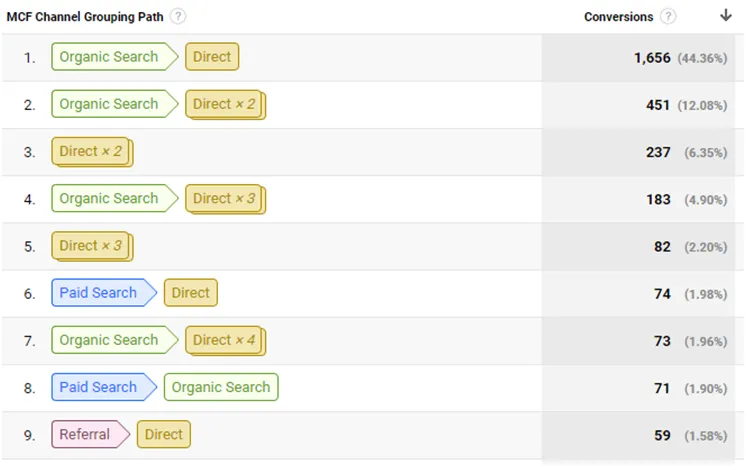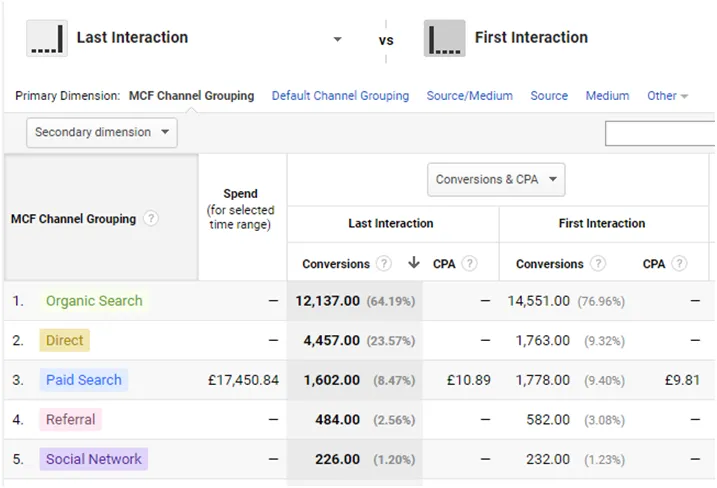Tracking customer journeys is an essential part of marketing, and in the digital space it is both easier to do and far more useable. Understanding where customers are coming from and which marketing channels are working is an absolute must for intelligent use of marketing spend.
And when it comes to tracking your customer journeys, you can never have enough data. Attribution models help businesses better understand what digital activities are really working and provide you with better insight into the nature of customer behaviour.
What are attribution models?
An attribution models are rules that determine how credit for online sales and conversions is assigned to touch points in conversion paths.
They allow you to see how your customers are finding your website and which channels are most effective for achieving conversions or the completion of website goals.
Attribution models are only the ruleset that determines the value of an interaction or touch point in a number of different scenarios. They don’t tell you anything themselves.
But by applying these rules to different activities, and comparing the value that each activity returns against the amount it costs to deliver, you can identify the return on investment from each of your digital marketing channels and campaigns.
Most businesses who track their website users’ behaviour look at a Last Interaction attribution models. Last Interaction attributions show which channel a user interacted with immediately before a website visit with a successful conversion action.
For example, someone might Google your brand name, click on your organic search listing and enter your website before completing a conversion.
A Last Interaction attribution model would assign all the credit for this conversion to natural search regardless of all steps that led to the moment they Googled your brand name. But what about all the steps and marketing activity that led to this point?
Don’t limit the scope of your data
The problem is that Last Interaction models are a simplified view of the conversion funnel and can lead to some very bad business choices.
Often times, businesses will look at Last Interaction attribution, see which channels are driving conversions and invest only in these areas.
If one channel is monopolising the last step in a customer journey, it can be easy to over invest in that channel. In the example above, it might be a fair assumption – given a Last Interaction attribution model – that it is worth investing heavily in SEO.
But if that search is actually a by-product of great brand awareness activity then this could easily be a poor use of marketing budget.
Types of attribution model
Last Interaction attribution along with its polar opposite, First Interaction, are simple to understand. They show you the first time your customer finds you and the channel they used to convert. But to get a clearer picture, you have to dig deeper. Very few customer journeys are so simple.
Research shows that it can take between 7 and 13 touch points with your brand before a conversion happens. With so many channels available from social media, digital advertising in its myriad forms, organic search and so on, today’s customer journeys are extremely complex.
Add in the variety of devices customers use to engage with brands and you start to appreciate how convoluted a typical customer journey can be.
So, how do you know where best to assign your marketing budget? Which channels are most effective? That’s where multi-touch attribution comes in.
Multi-touch attribution allows you to see the value of each customer touch point leading to a conversion. This helps you figure out which marketing channels or campaigns should be credited with the conversion, with the ultimate intention of allocating future spend to acquire new customers.
You can think of multi-touch attribution as a set of rules that give variable credit or “weight” to different marketing channels.
Key attribution models include:
Last Interaction
Last Interaction is both the most commonly used model and possibly the most inaccurate model in anything but the simplest of customer journeys. Last Interaction models assign 100% of revenue generated to the last customer touch point before a purchase.
First Interaction
First Interaction attribution attributes 100% of revenue to the first user touch point. For example, if a customer first comes across your brand by clicking on an organic search listing, and then later spends £100 on your website, organic search is said to have driven £100 of revenue.
Linear
A Linear model states that every step of the customer journey is equally responsible. It holds every touch point equal to the success of the conversion and assigns an equal portion of the revenue a customer spends.
Therefore, in a customer journey where the consumer had five interactions with the brand, each interaction will be credited with 20% of the revenue from that customer.
Positional
In order to buy something from you, the customer needs to know you exist. To successfully convert, they need to actually visit your site.
This philosophy supports the idea that, while the elements of a customer’s journey vary, they do not have as much value as the First Interaction and Last Interaction.
The Positional model follows this logic and represents it by combining aspects of First Interaction, Last Interaction and Linear.
Essentially, it says that the first touch point and the last touch point are worth X percent each, and all the other touch points in between have the remaining percentage divided up evenly among them.
Time Decay
Time Decay attribution models assign a percentage of the credit for conversion depending on how close in time to a conversion a touch point triggered.
How to change attribution models in Google Ads
If you want to change the attribution model for an existing conversion, follow these simple steps from your Google Ads account…
- From the top menu, select the tool icon
- Select Conversions. You can find this in the Measurements section
- Click the conversion you want to edit
- Click Edit Settings
- Click on Attribution Model, select an attribution model from the drop-down menu
- Click Save, then click Finished
Simple, right?
Remember, you can only do this in Google Ads. In Analytics, attributions default to Last Interaction, but you can use the Comparison Tool to dig deeper into the data if you need to.
Using attribution models
In their most basic form, attribution models are relatively straightforward to put into practice, but it may require some tweaking to your digital tracking. Everything you need is at your fingertips in Google Analytics.
The first step is to ensure that you have correctly implemented ecommerce tracking and goals via Google Analytics. Goals ought to cover only what you’d consider to be a legitimate conversion action, e.g. a sales enquiry, brochure download, quote request etc.
Once you’ve got your goals right, you can start to analyse the data collected against different attribution models. Start by checking out Top Conversion Paths in Google Analytics (hint: if you can’t find this, Analytics has a handy search function you can use).
This gives you a nice visual indication of the most common digital journeys to conversion. Below, you can see that the most common conversion path is a straightforward one, someone finds the site via a Google Search and then revisits directly before converting.
This immediately illustrates the flaws of a Last Interaction model, which would attribute most of the success to direct visits, whereas here organic search is clearly the biggest driver of conversions.

When you want to go into more depth, take a look at the Model Comparison Tool in Analytics. Here you can compare the models we’ve described and see how your conversion data is impacted
In the image below we’re comparing the most basic attribution models; Last Interaction vs. First Interaction. While the data can appear confusing, it is clear to see that all channels with the exception of direct visits are undervalued when using the Last Interaction model.

So, which attribution model is right for you?
Unfortunately, there is no simple answer to this question. The attribution method you choose will depend on a wide array of factors.
It is important to consider the complexity of your marketing mix, your competitors’ activity and the maturity of your business.
By analysing your marketing activity against each model, you start to fully appreciate the value of your channels. Multi-channel attribution models allow you to create typical customer journey maps and invest intelligently in the touchpoints that make these up.
Once you get the hang of correct attribution modelling you’ll likely find that the model you use depends on the individual journey or campaign.
Utilising multiple attribution models helps you answer difficult questions and ultimately allows you to make more informed investments without bias.Attribution models are just one aspect of Google Analytics, a tool that is essential for digital marketers. If you need guidance, advice or training on Google Analytics, get in touch.






